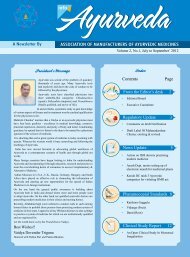3 In the Drugs and Cosmetics Rules, 1945 - amam-ayurveda.org
3 In the Drugs and Cosmetics Rules, 1945 - amam-ayurveda.org
3 In the Drugs and Cosmetics Rules, 1945 - amam-ayurveda.org
You also want an ePaper? Increase the reach of your titles
YUMPU automatically turns print PDFs into web optimized ePapers that Google loves.
38administration at 22 hours. Animals should be sacrificed 2 hours after colchicineadministration. Bone marrow from both <strong>the</strong> femora should be taken out, flushed withhypotonic saline (20 min.), pelletted <strong>and</strong> resuspended in Carnoy’s fluid. Once again<strong>the</strong> cells should be pelletted <strong>and</strong> dropped on clean glass slides with a Pasteur pipette.Giemsa staining should be done <strong>and</strong> increased number of aberrations in metaPhasechromosomes (minimum 100) should be used as <strong>the</strong> evaluation criteria.1.7 1.7 Carcinogenicity (see Appendix I, item 4.8)Carcinogenicity studies should be performed for all drugs that are expected to beclinically used for more than 6 months as well as for drugs used frequently in anintermittent manner in <strong>the</strong> treatment of chronic or recurrent conditions. Carcinogenicitystudies are also to be performed for drugs if <strong>the</strong>re is concern about <strong>the</strong>ir carcinogenicpotential emanating from previous demonstration of carcinogenic potential in <strong>the</strong>product class that is considered relevant to humans or where structure-activityrelationship suggests carcinogenic risk or when <strong>the</strong>re is evidence of preneoplasticlesions in repeated dose toxicity studies or when long-term tissue retention of parentcompound or metabolite(s) results in local tissue reactions or o<strong>the</strong>r pathophysiologicalresponses. For pharmaceuticals developed to treat certain serious diseases, LicensingAuthority may allow carcinogenicity testing to be conducted after marketing permissionhas been granted.<strong>In</strong> instances where <strong>the</strong> life-expectancy in <strong>the</strong> indicated population is short (i.e., less than2 - 3 years) - no long-term carcinogenicity studies may be required. <strong>In</strong> cases where <strong>the</strong><strong>the</strong>rapeutic agent for cancer is generally successful <strong>and</strong> life is significantly prolonged<strong>the</strong>re may be later concerns regarding secondary cancers. When such drugs are intendedfor adjuvant <strong>the</strong>rapy in tumour free patients or for prolonged use in non-cancerindications, carcinogenicity studies may be / are needed. Completed rodentcarcinogenicity studies are not needed in advance of <strong>the</strong> conduct of large scale clinicaltrials, unless <strong>the</strong>re is special concern for <strong>the</strong> patient population.Carcinogenicity studies should be done in a rodent species (preferably rat). Mouse maybe employed only with proper scientific justification. The selected strain of animalsshould not have a very high or very low incidence of spontaneous tumors.




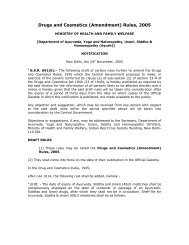
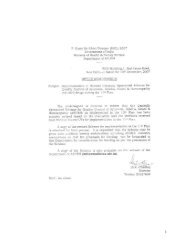

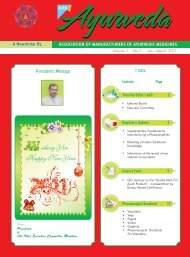

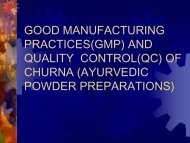
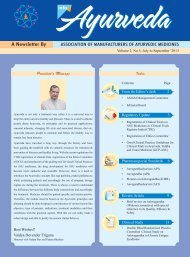
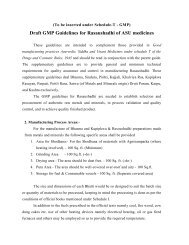
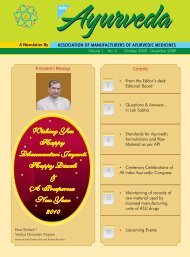
![[To be published in Gazette of India Part II Section 3, sub-section iii]](https://img.yumpu.com/28570283/1/190x245/to-be-published-in-gazette-of-india-part-ii-section-3-sub-section-iii.jpg?quality=85)

